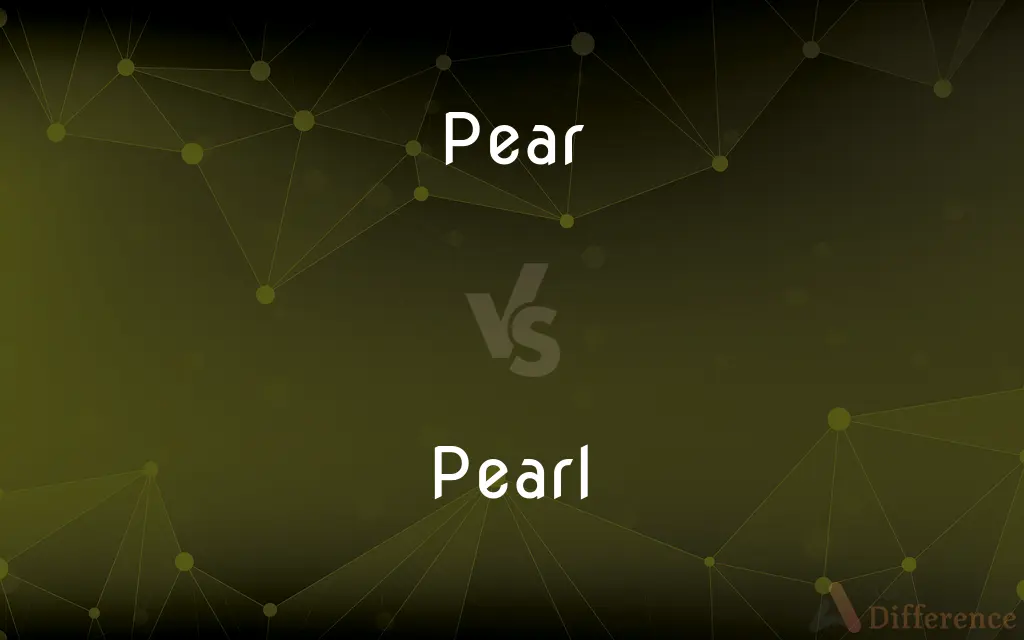Pear vs. Pearl — What's the Difference?
By Fiza Rafique & Maham Liaqat — Updated on April 8, 2024
A pear is a sweet, bell-shaped fruit, while a pearl is a hard, shiny object produced within the soft tissue of a living shelled mollusk.

Difference Between Pear and Pearl
Table of Contents
ADVERTISEMENT
Key Differences
Pears are edible fruits grown on trees, known for their sweet flavor and juicy texture, often consumed fresh, canned, or used in cooking and baking. Pearls, in contrast, are precious gems formed inside mollusks as a defense mechanism against potentially harmful irritants.
While the cultivation of pears is a form of agriculture involving horticulture practices to produce fruit, pearl formation is a natural biological process that can also be induced artificially in pearl farms. Pears are part of human diets, contributing vitamins and fiber, whereas pearls are used in jewelry and adornment, valued for their luster and beauty.
The lifespan of a pear tree can span several decades, producing fruit annually, whereas pearls can take years to form within a mollusk. Once harvested, pears have a relatively short shelf life, needing to be consumed or preserved, while pearls, being non-perishable, can last indefinitely with proper care.
The cultural significance of pears varies widely, often associated with health and vitality in many traditions. Pearls, however, have been symbols of wealth, purity, and elegance across various cultures and histories.
Understanding the distinction between pear and pearl highlights not only their different physical characteristics but also their uses, value, and the methods by which they are produced, showcasing the diversity of natural and cultivated products utilized by humans.
ADVERTISEMENT
Comparison Chart
Nature
Fruit
Gemstone
Source
Pear trees (Genus Pyrus)
Mollusks (especially oysters and clams)
Use
Consumption (eaten fresh or in recipes)
Adornment (jewelry)
Formation
Agricultural cultivation
Natural or cultured process in mollusks
Lifespan/Perishability
Perishable, with a short shelf life after harvest
Non-perishable, lasting indefinitely with care
Cultural Significance
Often symbolizes health, vitality
Represents wealth, purity, elegance
Compare with Definitions
Pear
Can be canned, juiced, or dried for various culinary uses.
Pear jam is a delicious way to preserve the fruit's flavor.
Pearl
A lustrous gem formed inside the shell of a mollusk.
The necklace featured a single, luminous pearl.
Pear
Grown on trees, pears are a popular choice for fresh eating and baking.
Pears are harvested in the fall, filling orchards with their sweet aroma.
Pearl
The quality of pearls is judged by their luster, size, and shape.
The rounder and smoother the pearl, the higher its value.
Pear
Pears are rich in dietary fiber and vitamin C.
Adding a pear to her breakfast was a healthy choice.
Pearl
Pearls are valued in jewelry for their beauty and rarity.
Her pearl earrings were the perfect touch of elegance.
Pear
A sweet, juicy fruit with a rounded base and tapering top.
She enjoyed a ripe pear for dessert.
Pearl
Can be natural or cultured, with cultured pearls being more common.
Cultured pearls are created by inserting a nucleus into an oyster.
Pear
Varieties include Bartlett, Anjou, and Bosc, each with distinct flavors.
Bosc pears are excellent for baking due to their firm texture.
Pearl
Historically symbolizes purity and wealth.
In ancient times, pearls were treasures only kings could afford.
Pear
Pears are fruits produced and consumed around the world, growing on a tree and harvested in late Summer into October. The pear tree and shrub are a species of genus Pyrus , in the family Rosaceae, bearing the pomaceous fruit of the same name.
Pearl
A pearl is a hard, glistening object produced within the soft tissue (specifically the mantle) of a living shelled mollusk or another animal, such as fossil conulariids. Just like the shell of a mollusk, a pearl is composed of calcium carbonate (mainly aragonite or a mixture of aragonite and calcite) in minute crystalline form, which has deposited in concentric layers.
Pear
A sweet yellowish- or brownish-green edible fruit that is typically narrow at the stalk and wider towards the base, with sweet, slightly gritty flesh.
Pearl
A hard, lustrous spherical mass, typically white or bluish-grey, formed within the shell of a pearl oyster or other bivalve mollusc and highly prized as a gem
A linen garment decorated with pearls
A pair of pearl earrings
Necklaces of amethyst and pearl
Pear
The Eurasian tree which bears the pear.
Pearl
A person or thing of great worth
He has some pearls of wisdom to offer
Pear
Any of several trees of the genus Pyrus in the rose family, having glossy leaves and white flowers, especially P. communis, widely cultivated for its edible fruit.
Pearl
Another term for picot
Pear
The fruit of any of these trees, having gritty, juicy flesh and usually a shape that is spherical at the base and tapering toward the stalk.
Pearl
Form drops resembling pearls
Raindrops pearled on water-soaked windowpanes
Pear
An edible fruit produced by the pear tree, similar to an apple but typically elongated towards the stem.
Pearl
Dive or fish for pearl oysters
The pearling industry
Pear
A type of fruit tree (Pyrus communis).
Pearl
A smooth, lustrous, variously colored mass, chiefly of calcium carbonate, formed around a grain of sand or other foreign matter inside the shell of certain bivalve mollusks and valued as a gem.
Pear
The wood of the pear tree (pearwood, pear wood).
Pearl
A bead resembling one of these masses.
Pear
Choke pear (a torture device).
Pearl
Something small and spherical in shape
"pearls of sweat beading on her upper lip" (Katherine Min).
Pear
(Jamaica) avocado, alligator pear
Pearl
Mother-of-pearl; nacre.
Pear
A desaturated chartreuse yellow colour, like that of a pear.
Pearl
One that is highly regarded for its beauty or value.
Pear
The fleshy pome, or fruit, of a rosaceous tree (Pyrus communis), cultivated in many varieties in temperate climates; also, the tree which bears this fruit. See Pear family, below.
Pearl
(Printing) A type size measuring approximately five points.
Pear
Sweet juicy gritty-textured fruit available in many varieties
Pearl
A yellowish white.
Pear
Old World tree having sweet gritty-textured juicy fruit; widely cultivated in many varieties
Pearl
To decorate or cover with pearls or beads resembling pearls.
Pearl
To make into the shape or color of pearls.
Pearl
To dive or fish for pearls or pearl-bearing mollusks.
Pearl
To form beads resembling pearls.
Pearl
Variant of purl2.
Pearl
A shelly concretion, usually rounded, and having a brilliant luster, with varying tints, found in the mantle, or between the mantle and shell, of certain bivalve mollusks, especially in the pearl oysters and river mussels, and sometimes in certain univalves. It is usually due to a secretion of shelly substance around some irritating foreign particle. Its substance is the same as nacre, or mother-of-pearl. Round lustrous pearls are used in jewellery.
Pearl
(figuratively) Something precious.
Pearl
A capsule of gelatin or similar substance containing liquid for e.g. medicinal application.
Pearl
Nacre, or mother-of-pearl.
Pearl
A whitish speck or film on the eye.
Pearl
A fish allied to the turbot; the brill.
Pearl
A light-colored tern.
Pearl
One of the circle of tubercles which form the bur on a deer's antler.
Pearl
The size of type between diamond and agate, standardized as 5-point.
Pearl
A fringe or border.
Pearl
(obsolete) A jewel or gem.
Pearl
(figurative) A valuable little nugget of information; especially, an aphorism or tip#Etymology 5 that is operationally useful for decision-making.
Pearl of wisdom
Clinical pearls
Pearl
The clitoris.
Pearl
To set or adorn with pearls, or with mother-of-pearl.
Pearl
(transitive) To cause to resemble pearls in shape; to make into small round grains.
To pearl barley
Pearl
(transitive) To cause to resemble pearls in lustre or iridescence.
Pearl
(intransitive) To resemble pearl or pearls.
Pearl
(intransitive) To hunt for pearls
To go pearling
Pearl
To sink the nose of one's surfboard into the water, often on takeoff.
Pearl
Of the nose of the surfboard: to sink in this manner.
Pearl
A fringe or border.
Pearl
A shelly concretion, usually rounded, and having a brilliant luster, with varying tints, found in the mantle, or between the mantle and shell, of certain bivalve mollusks, especially in the pearl oysters and river mussels, and sometimes in certain univalves. It is usually due to a secretion of shelly substance around some irritating foreign particle. Its substance is the same as nacre, or mother-of-pearl.
Pearl
Hence, figuratively, something resembling a pearl; something very precious.
I see thee compassed with thy kingdom's pearl.
And those pearls of dew she wears.
Pearl
Nacre, or mother-of-pearl.
Pearl
A fish allied to the turbot; the brill.
Pearl
A light-colored tern.
Pearl
One of the circle of tubercles which form the bur on a deer's antler.
Pearl
A whitish speck or film on the eye.
Pearl
A capsule of gelatin or similar substance containing some liquid for medicinal application, as ether.
Pearl
A size of type, between agate and diamond.
Pearl
Of or pertaining to pearl or pearls; made of pearls, or of mother-of-pearl.
Pearl
To set or adorn with pearls, or with mother-of-pearl. Used also figuratively.
Pearl
To cause to resemble pearls; to make into small round grains; as, to pearl barley.
Pearl
To resemble pearl or pearls.
Pearl
To dive or hunt for pearls; as, to go pearling.
Pearl
A smooth lustrous round structure inside the shell of a clam or oyster; much valued as a jewel
Pearl
A shade of white the color of bleached bones
Pearl
A shape that is small and round;
He studied the shapes of low-viscosity drops
Beads of sweat on his forehead
Pearl
Gather pearls, from oysters in the ocean
Common Curiosities
Are all pearls white?
No, pearls can come in various colors, including white, black, pink, and golden, depending on the type of mollusk and its environment.
What is a pear?
A pear is a sweet, bell-shaped fruit that grows on trees, known for its juicy texture.
How are pearls formed?
Pearls are formed inside the soft tissue of mollusks as a response to irritants, naturally or through human intervention.
Can you eat pears raw?
Yes, pears are commonly eaten raw and are prized for their sweet, juicy flesh.
What part of the pear is edible?
The flesh of the pear is edible, though some people choose to remove the skin and core.
Why are pearls valuable?
Pearls are valuable due to their rarity, the time it takes to form them, and their use in fine jewelry.
What are the health benefits of pears?
Pears are a good source of dietary fiber, vitamin C, and various antioxidants.
What makes a pearl valuable?
The value of a pearl is determined by its luster, color, size, and shape, with round, lustrous pearls being the most prized.
How long does it take for a pear tree to produce fruit?
Pear trees can take several years to mature and start producing fruit, typically 3 to 5 years after planting.
How are cultured pearls made?
Cultured pearls are made by inserting a small bead or piece of tissue into a mollusk, prompting it to form a pearl.
How do you determine the quality of a pearl?
Pearl quality is assessed based on its size, shape, color, surface quality, and luster.
What dishes can you make with pears?
Pears can be used in a variety of dishes, from salads and desserts to sauces and baked goods.
Do pearls require special care?
Yes, pearls are delicate and require careful handling to maintain their luster and prevent damage.
What is the difference between natural and cultured pearls?
Natural pearls form without human intervention, while cultured pearls are created by deliberately inserting an irritant into a mollusk.
Can pears grow in any climate?
Pears are adaptable but grow best in temperate climates.
Share Your Discovery

Previous Comparison
Fluorometer vs. Spectrofluorometer
Next Comparison
Detective vs. TecAuthor Spotlight
Written by
Fiza RafiqueFiza Rafique is a skilled content writer at AskDifference.com, where she meticulously refines and enhances written pieces. Drawing from her vast editorial expertise, Fiza ensures clarity, accuracy, and precision in every article. Passionate about language, she continually seeks to elevate the quality of content for readers worldwide.
Co-written by
Maham Liaqat















































